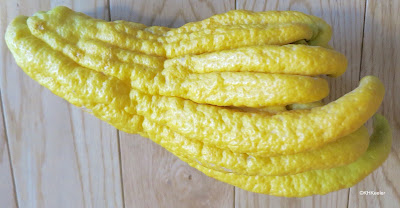This is the Buddha's hand citron:
 |
| Buddha's hand citron, Citron medica var. sarcodactylis |
It rarely appears in North American markets, but is common in Asia.
The citron (Citrus medica, citrus family, Rutaceae) is one of the oldest citrus fruits. While there are wild citrus, genus Citrus, in southeast Asia, all the fruits we eat are cultivated hybrids, produced over the last several thousand years. Ordinary citrons grow to be warty-surfaced fruits, usually yellow when ripe, about the size of a large orange, but more oval than round. Inside is a thick layer of pulp around the seeds and very little flesh. They are unpleasantly acidic, so, like lemons, they are used in cooking, not eaten alone or fresh. That said, citrons were the first citrus fruit to reach the Middle East, north Africa, and Europe, so they were widely used and enjoyed. They were frequently pickled in various ways, which led to confusion with a variety of watermelon (Citrullus lanatus, cucumber family, Cucurbitaceae) that is similar in size and shape, if seen for sale in the market, and that was also mainly used pickled. Growing, it is easy to distinguish the two citrons; the citrus citron grows on a tree, the watermelon citron grows on a vine. The etrog variety of citron, Citrus medica var. ertrog, is the one used in the Jewish Feast of the Tabernacle.
 |
| etrog citron, Citrus medica var. etrog |
But the citron has a dramatically different variety as well: the Buddha's hand citron. It is a developmental mutant; the carpels containing the seeds never fuse together to make a round fruit. The first record of it is in writings of the Tang Dynasty in China, in the 7th century. Since then, it has often appeared in Asian art, whether in paintings, porcelain, or sculpture.
Like other citrus fruits, the Buddha's hand citron has a lovely scent. Like other citrons, it is too sour to eat directly. The Chinese ate it candied or as flavoring for sweets or tea.
Most often, though, Asians used them as a decorations. Traditional Chinese culture made extensive use of fragrant plants to refresh indoor spaces. This citron was widely grown and set inside as a citrusy decoration. Since the shape was similar to the classic position of Buddha's hand, Buddha's hand citrons added a reminder of Buddha to the room, as well as the scent. Potted plants are highly prized.
 |
| Buddha's hand citron, Citrus medica var. sarcodactylis a glimpse inside |
 |
| Buddha's hand citron, Citrus medica var. sarcodactylis |
I am wishing you luck, wealth, and longevity as we start the new year of the lunar calendar, the Year of the Water Rabbit.
Comments and corrections welcome.
Note on the Asian lunar calendar: It has a 12-year cycle with a different animal each year. But there is a second, 5-year cycle of the elements, wood, fire, earth, metal and water, which turns simultaneously, so that a water rabbit year occurs only once every 60 years. Hence the importance of the 60th birthday to people who observe the lunar calendar; it is the first time "their" year has reappeared in their lifetime. In the lunar calendars of Asia, year of the rabbit--1939, 1951, 1963, 1975, 1987, 1999, 2011, and 2023--is likely to be a fortunate and prosperous year; to be born then is quite auspicious. Rabbits are portrayed as thoughtful, kind, and fertile animals. The element water represents inner wisdom and sound intuition, making the Water Rabbit a powerful sign.
I find the lunar calendar fascinating for the idea that groups of 12 and 60 years form a cycle, not moving in the linear progression typical of western calendars.
References
Anonymous. 12 Signs of the Chinese Zodiac. link Accessed 1/21/23.
Barnes, Tracey Jane. The Year of the Water Rabbit. Facebook feed. If you can find this, it is a good summary. Accessed 1/22/23
Needham, J. 1986. Science and Civilization in China. Vol VI:I Botany. Cambridge University Press, Cambridge.
Valder, P. 1996. Garden Plants of China. Timber Press. Portland, OR.
Wright, J. 2023. Chinese Zodiac Elements: How to Know What Yours Is and What It Means. PureWow.com link Accessed 1/21/23.
Wu, G.A. et al. 2018. Genomics of the origin and evolution of Citrus. Nature. 554:311-316. link accessed 1/21/23.
No comments:
Post a Comment